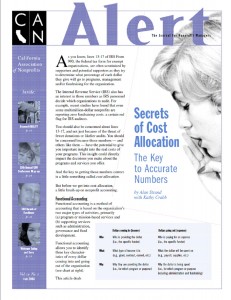 A few years back I co-wrote an article about getting accurate numbers from your financial system for the California Association of Nonprofits that was based on a workshop I developed. These next two blog posts will excerpt some of the material from that piece. For folks who would like the whole article you can click the above link. This first post will be on cost allocation, the second post will be on setting up a functional accounting system.
A few years back I co-wrote an article about getting accurate numbers from your financial system for the California Association of Nonprofits that was based on a workshop I developed. These next two blog posts will excerpt some of the material from that piece. For folks who would like the whole article you can click the above link. This first post will be on cost allocation, the second post will be on setting up a functional accounting system.
Cost allocation should not be ignored as a cornerstone of your financial management and reporting. It is critically important to all aspects of your organization: How you budget from year to year, how you make management decisions, how you appear to potential supporters and the amount you are reimbursed for services all depend on proper and consistent cost allocation.
Allocation can look tricky at first glance, and initially it can be difficult to set up a reliable, consistent and simple system. But once your system is in place, it should go rather smoothly and become a routine part of your accounting and financial reporting process. Put some thought and planning into developing a method that works for you and that best reflects the reality of what happens in your organization from day to day.
Cost allocation is a method for apportioning shared expenses or shared costs (also called common costs, or directly allocable costs) across functional areas. It generally works well to “dump” all shared costs into cost centers – temporary holding tanks for functional areas – and then allocate them out across those functional areas on a periodic basis, usually monthly or yearly.
As an example say you get a bill from your office supply store for $500, you would initially expense it to “Supplies” and code it to a cost center. But at month-end, year-end or whenever you allocate costs, you will want to divide out that $500 between the specific functional areas that actually used the office supplies. So you might end up with $50 of that bill being allocated to management, $75 to fundraising and $375 proportionately across various programs. Your allocation method is your way of deciding what percentage of that bill to apportion to each functional area.
Cost allocation is important because, done accurately and consistently, it can provide a realistic picture of what different programs and other activities cost. Your allocation method also determines the percentages of program, management and fundraising that will appear on your Form 990 and other reports – numbers that potential donors use to judge your organization’s worthiness for their contributions. It is also used in cost recovery for reimbursable expenses, directly impacting your bottom line and related fundraising decisions.
There are a number of cost allocation methods out there, and several of the most common are:
- Payroll. Allocations are based on a percentage of the total actual time worked or the total payroll dollars charged by all employees in each functional area. For example, four employees’ time sheet data shows that they spent 15 percent of their aggregated time during the last payroll period on Program A, 35 percent of their aggregated time on Program B, 25 percent on program C, 15 percent on Administration and 10 percent on Fundraising.
- Cost-to-cost or direct cost. Allocations are based on the previous year’s percentage breakdowns for each functional area.
- Square footage. Allocations are based on the proportionate space occupied by each functional area in your office or worksite. For example, Program A occupies 10 percent of your office space, Program B occupies 20 percent, Program C 50 percent, Administration 5 percent and Fundraising 15 percent. This method is useful for allocating rent, utilities and other occupancy-related costs.
Your organization might require a method not included above, or more than one method of cost allocation, for example using payroll for personnel-related expenses and square footage for office-related expenses. You might have to pick and choose which method or methods work best for your organization in terms of both your available time and the accuracy of the data produced. That said, if you have many different allocation methods, some consolidation might be in order. Whatever method(s) you decide to use, you should use it consistently, put it in writing, have it approved by the executive director and be able to back it up if questioned about it. It should also be honest and ethical – not a method you would regret being described in a front-page story in your local newspaper.
If you would like to learn about creating a cost allocation policy for your nonprofit please click on the image below.



 As part of my follow-up to recent workshops that I’ve run in the last few weeks I wanted to answer a few questions. But first I wanted to thank
As part of my follow-up to recent workshops that I’ve run in the last few weeks I wanted to answer a few questions. But first I wanted to thank